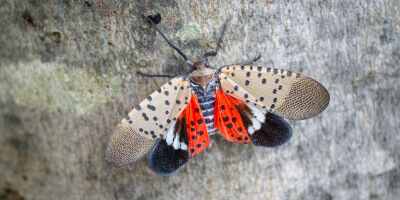Spotted Lanternfly Facts & Information
Everything you need to know about spotted lanternflies
WHAT DO spotted lanternflies LOOK LIKE

Spotted lanternflies get their name from the distinguishable black spots on their front wings as adults. Adult SLF have spotted forewings that cover brightly-colored hind wings. Spotted lanternfly nymphs are usually 1/8 to 1/2 inch in size with white-spotted, black bodies changing to bright red coloration in older nymphs. Adults are larger than nymphs, around 1 inch in length and an inch and a half wide when wings are spread. The adults are typically easier to find because of their size, coloration, and increased mobility.
Spotted lanternflies are a type of planthopper and although they have wings, they only fly short distances and primarily jump or walk. Spotted lanternflies lay their eggs in the fall and hatch in the spring. They lay their eggs on hard surfaces, such as homes, trees, rocks, etc. and lay an average of 30-50 eggs at a time. Spotted lanternflies go through several stages as an immature nymph, in which they grow wings and change color. Adult spotted lanternflies emerge in the summer and their entire lifespan usually lasts around one year. Spotted lanternflies feed on both woody plants and non-woody plants, including trees and a variety of plant species.
Spotted lanternflies are a type of planthopper and although they have wings, they only fly short distances and primarily jump or walk. Spotted lanternflies lay their eggs in the fall and hatch in the spring. They lay their eggs on hard surfaces, such as homes, trees, rocks, etc. and lay an average of 30-50 eggs at a time. Spotted lanternflies go through several stages as an immature nymph, in which they grow wings and change color. Adult spotted lanternflies emerge in the summer and their entire lifespan usually lasts around one year. Spotted lanternflies feed on both woody plants and non-woody plants, including trees and a variety of plant species.
Where do spotted lanternflies live
The Spotted Lanternfly is a relatively new invasive species to the United States. Native to Asia, namely China, India, and Vietnam, the spotted lanternfly was first documented in the U.S. in 2014, in Berks County, Pennsylvania. It is now considered an invasive species throughout southeastern Pennsylvania, southwestern New Jersey, northern Delaware, and northern Virginia. They have recently been spotted as far north as Massachusetts, as far south as North Carolina, and as far west as Tennesee, so there’s no reason why they can’t spread further. They are a huge threat to agriculture throughout the areas they invade. And can be a huge nuisance.
Spotted lanternflies’ preferred host to feed and mate on is the tree-of-heaven , an invasive plant first introduced to the Philadelphia-area in the 18th century. However, they have been known to host on over 70 other plant species and will lay eggs just about anywhere.
Spotted lanternflies’ preferred host to feed and mate on is the tree-of-heaven , an invasive plant first introduced to the Philadelphia-area in the 18th century. However, they have been known to host on over 70 other plant species and will lay eggs just about anywhere.
How did I get spotted lanternflies
You are no different than anyone else in our area. These invasive pests got here and, it seemed quite suddenly started to multiply. There was nothing any of us could do to stop them coming. If you have the kinds of plants they prefer, then they will show up. So, you didn’t do anything that attracted them. It’s not like you left your garbage cans open or have a bird feeder with seeds falling out the bottom and are wondering why you have rats. The spotted lanternfly goes where it wishes and is expanding further and further into the United States every year. You can have professional spotted lanternfly treatments done so that every life stage (adult spotted lanternflies, spotted lanternfly nymphs, and spotted lanternfly egg sacs) are taken care of.
what Problems do spotted lanternflies cause
Spotted lanternflies do not bite or sting humans, but they are a major destructive pest. They are a huge agricultural threat to plants and trees such as grapes, hops, and hardwoods, causing costly damage. They are also a nuisance and can affect the quality of life in the areas they invade because they will congregate in large numbers. Spotted lanternflies harm their host plants by feeding on the plant’s sap, leading to weeping wounds of sap and mold, which can result in stunted growth or even plant death.
In addition, they are terrible flyers. If you’ve been to a kid’s baseball or football game, you know that they end up flying into your head, landing right on your leg, or just plain jumping around. They aren’t going to harm you but if you’ve heard a shout of surprise when you’re eating outside at a restaurant, it could be that the spotted lanternfly has made their patented sudden appearance.
In addition, they are terrible flyers. If you’ve been to a kid’s baseball or football game, you know that they end up flying into your head, landing right on your leg, or just plain jumping around. They aren’t going to harm you but if you’ve heard a shout of surprise when you’re eating outside at a restaurant, it could be that the spotted lanternfly has made their patented sudden appearance.
How can I prevent spotted lanternflies
People throughout New Jersey, New York, Pennsylvania, Delaware, and Connecticut are encouraged to help stop the spread of spotted lanternflies by checking cars and any outdoor equipment, like grills, playground equipment, firewood, and lawnmowers, when traveling in and out of the quarantined zones. If you find an infestation on your property, there are a number of spotted lanternfly control methods to manage the invasion. You should scrape any visible egg masses off of trees and properly destroy them.
Removing the tree-of-heaven on your property can help since that’s their host of choice. Banding trees where spotted lanternflies are detected will help your pest control professional identify the trees that need to be treated. When there are only a few insects, you can kill spotted lanternflies by swatting or crushing them but if you’ve ever been in a parking lot and seen people trying to crush them, you know that they are terrible flyers but super-fast hoppers. The best thing you can do is have professional spotted lanternfly treatments done seasonally.
Removing the tree-of-heaven on your property can help since that’s their host of choice. Banding trees where spotted lanternflies are detected will help your pest control professional identify the trees that need to be treated. When there are only a few insects, you can kill spotted lanternflies by swatting or crushing them but if you’ve ever been in a parking lot and seen people trying to crush them, you know that they are terrible flyers but super-fast hoppers. The best thing you can do is have professional spotted lanternfly treatments done seasonally.
why western for spotted lanternfly control
We’re passionate about controlling spotted lanternflies around your home or business because we live and work here – it’s our neighborhood, too. With our almost 100 years of experience keeping homes and businesses in Connecticut, Delaware, New Jersey, New York, and Pennsylvania safe from pests, Western has the experience you can trust.
100% Satisfaction Guarantee
24-Hour Guaranteed Response
Board Certified Entomologists
Consider spotted lanternflies controlled.
GET MY QUOTE
